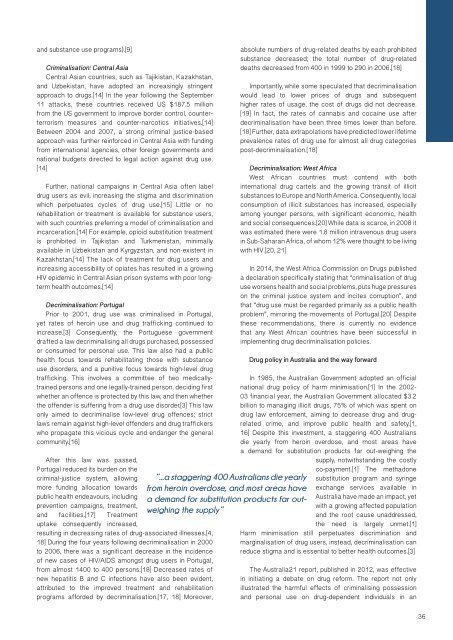Vector Volume 11 Issue 2 - 2017
Create successful ePaper yourself
Turn your PDF publications into a flip-book with our unique Google optimized e-Paper software.
and substance use programs).[9]<br />
Criminalisation: Central Asia<br />
Central Asian countries, such as Tajikistan, Kazakhstan,<br />
and Uzbekistan, have adopted an increasingly stringent<br />
approach to drugs.[14] In the year following the September<br />
<strong>11</strong> attacks, these countries received US $187.5 million<br />
from the US government to improve border control, counterterrorism<br />
measures and counter-narcotics initiatives.[14]<br />
Between 2004 and 2007, a strong criminal justice-based<br />
approach was further reinforced in Central Asia with funding<br />
from international agencies, other foreign governments and<br />
national budgets directed to legal action against drug use.<br />
[14]<br />
Further, national campaigns in Central Asia often label<br />
drug users as evil, increasing the stigma and discrimination<br />
which perpetuates cycles of drug use.[15] Little or no<br />
rehabilitation or treatment is available for substance users,<br />
with such countries preferring a model of criminalisation and<br />
incarceration.[14] For example, opioid substitution treatment<br />
is prohibited in Tajikistan and Turkmenistan, minimally<br />
available in Uzbekistan and Kyrgyzstan, and non-existent in<br />
Kazakhstan.[14] The lack of treatment for drug users and<br />
increasing accessibility of opiates has resulted in a growing<br />
HIV epidemic in Central Asian prison systems with poor longterm<br />
health outcomes.[14]<br />
Decriminalisation: Portugal<br />
Prior to 2001, drug use was criminalised in Portugal,<br />
yet rates of heroin use and drug trafficking continued to<br />
increase.[3] Consequently, the Portuguese government<br />
drafted a law decriminalising all drugs purchased, possessed<br />
or consumed for personal use. This law also had a public<br />
health focus towards rehabilitating those with substance<br />
use disorders, and a punitive focus towards high-level drug<br />
trafficking. This involves a committee of two medicallytrained<br />
persons and one legally-trained person, deciding first<br />
whether an offence is protected by this law, and then whether<br />
the offender is suffering from a drug use disorder.[3] This law<br />
only aimed to decriminalise low-level drug offences; strict<br />
laws remain against high-level offenders and drug traffickers<br />
who propagate this vicious cycle and endanger the general<br />
community.[16]<br />
After this law was passed,<br />
Portugal reduced its burden on the<br />
criminal-justice system, allowing<br />
more funding allocation towards<br />
public health endeavours, including<br />
prevention campaigns, treatment,<br />
and facilities.[17] Treatment<br />
uptake consequently increased,<br />
resulting in decreasing rates of drug-associated illnesses.[4,<br />
18] During the four years following decriminalisation in 2000<br />
to 2006, there was a significant decrease in the incidence<br />
of new cases of HIV/AIDS amongst drug users in Portugal,<br />
from almost 1400 to 400 persons.[18] Decreased rates of<br />
new hepatitis B and C infections have also been evident,<br />
attributed to the improved treatment and rehabilitation<br />
programs afforded by decriminalisation.[17, 18] Moreover,<br />
“...a staggering 400 Australians die yearly<br />
from heroin overdose, and most areas have<br />
a demand for substitution products far outweighing<br />
the supply”<br />
absolute numbers of drug-related deaths by each prohibited<br />
substance decreased; the total number of drug-related<br />
deaths decreased from 400 in 1999 to 290 in 2006.[18]<br />
Importantly, while some speculated that decriminalisation<br />
would lead to lower prices of drugs and subsequent<br />
higher rates of usage, the cost of drugs did not decrease.<br />
[19] In fact, the rates of cannabis and cocaine use after<br />
decriminalisation have been three times lower than before.<br />
[18] Further, data extrapolations have predicted lower lifetime<br />
prevalence rates of drug use for almost all drug categories<br />
post-decriminalisation.[18]<br />
Decriminalisation: West Africa<br />
West African countries must contend with both<br />
international drug cartels and the growing transit of illicit<br />
substances to Europe and North America. Consequently, local<br />
consumption of illicit substances has increased, especially<br />
among younger persons, with significant economic, health<br />
and social consequences.[20] While data is scarce, in 2008 it<br />
was estimated there were 1.8 million intravenous drug users<br />
in Sub-Saharan Africa, of whom 12% were thought to be living<br />
with HIV.[20, 21]<br />
In 2014, the West Africa Commission on Drugs published<br />
a declaration specifically stating that “criminalisation of drug<br />
use worsens health and social problems, puts huge pressures<br />
on the criminal justice system and incites corruption”, and<br />
that “drug use must be regarded primarily as a public health<br />
problem”, mirroring the movements of Portugal.[20] Despite<br />
these recommendations, there is currently no evidence<br />
that any West African countries have been successful in<br />
implementing drug decriminalisation policies.<br />
Drug policy in Australia and the way forward<br />
In 1985, the Australian Government adopted an official<br />
national drug policy of harm minimisation.[1] In the 2002-<br />
03 financial year, the Australian Government allocated $3.2<br />
billion to managing illicit drugs, 75% of which was spent on<br />
drug law enforcement, aiming to decrease drug and drugrelated<br />
crime, and improve public health and safety.[1,<br />
16] Despite this investment, a staggering 400 Australians<br />
die yearly from heroin overdose, and most areas have<br />
a demand for substitution products far out-weighing the<br />
supply, notwithstanding the costly<br />
co-payment.[1] The methadone<br />
substitution program and syringe<br />
exchange services available in<br />
Australia have made an impact, yet<br />
with a growing affected population<br />
and the root cause unaddressed,<br />
the need is largely unmet.[1]<br />
Harm minimisation still perpetuates discrimination and<br />
marginalisation of drug users, instead, decriminalisation can<br />
reduce stigma and is essential to better health outcomes.[3]<br />
The Australia21 report, published in 2012, was effective<br />
in initiating a debate on drug reform. The report not only<br />
illustrated the harmful effects of criminalising possession<br />
and personal use on drug-dependent individuals in an<br />
36

















